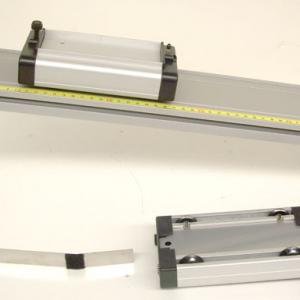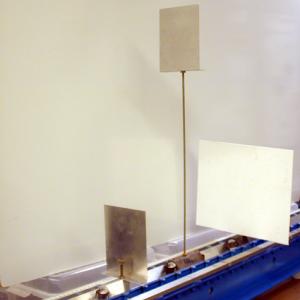College of Liberal Arts & Sciences
1K20.14 - Variable Friction - Dynamics Track or Air Track
The dynamics track can be either level of inclined for this demonstration. Set the desired amount of friction on the cart by turning the large screw. Pulleys, masses, and an interface with sensors may also be used for this demonstration.
Set the desired screen on a car and give it a push on a level air track. The car will visibly slow down if the screen is big enough, or you can measure the velocity of the car with a sonic sensor. A couple of photogates may also be used to take velocity measurements of the car at several points during its run.
- Michele D'Anna, Tommaso Corridoni, "Magnetic Force from Terminal Velocity", TPT, Vol. 58, #9, Dec. 2020, p. 642.
- Nuri Balta, "Oscillations of a Meterstick on Two Rotating Shafts", TPT, Vol. 54, #3, Mar. 2016, p. 145.
- Joseph C. Amato and Roger E. Williams, "Turning a Common Lab Exercise into a Challenging Lab Experiment: Revisiting the Cart on an Inclined Track", TPT, Vol. 48, #5, May 2010, p. 322.
- Martin Kamela, "An Oscillating System with Sliding Friction", TPT, Vol. 45, #2, Feb. 2007, p. 110.
- Roger F. Larson, "Measuring the Coefficient of Friction of A Low-Friction Cart", TPT, Vol. 36 #8, Nov. 1998, p. 464.
- Robert P. Barrett, "The Author Replies", TPT, Vol. 13, #2, Feb. 1975, p. 68.
- John Kwasnoski, "Average Friction and Average Velocity", TPT, Vol. 13, #2, Feb. 1975, p. 68.
- Robert P. Barrett, "Friction on the Air Track", TPT, Vol. 12, #5, May 1974, p. 297.
- Peter F. Hinrichsen, "The Toppling of a Uniform Rectangular Block", AJP, Vol. 89, #11, Nov. 2021, p. 1026.
Disclaimer: These demonstrations are provided only for illustrative use by persons affiliated with The University of Iowa and only under the direction of a trained instructor or physicist. The University of Iowa is not responsible for demonstrations performed by those using their own equipment or who choose to use this reference material for their own purpose. The demonstrations included here are within the public domain and can be found in materials contained in libraries, bookstores, and through electronic sources. Performing all or any portion of any of these demonstrations, with or without revisions not depicted here entails inherent risks. These risks include, without limitation, bodily injury (and possibly death), including risks to health that may be temporary or permanent and that may exacerbate a pre-existing medical condition; and property loss or damage. Anyone performing any part of these demonstrations, even with revisions, knowingly and voluntarily assumes all risks associated with them.

